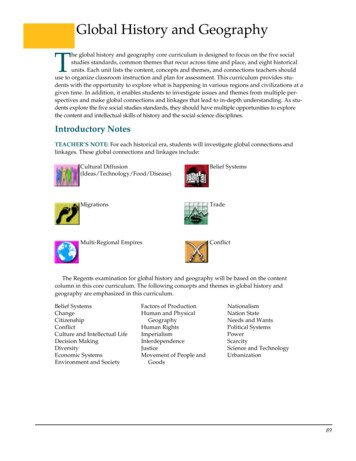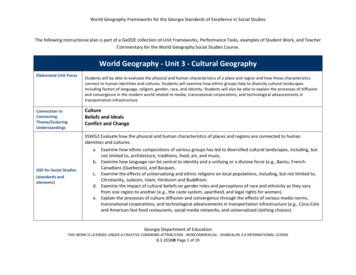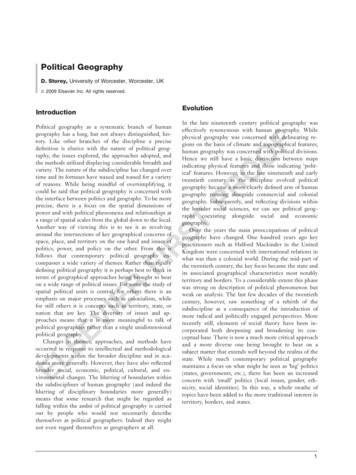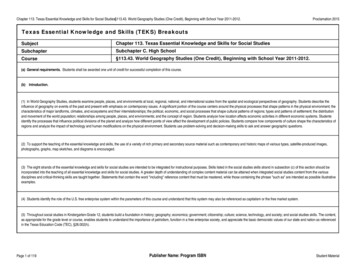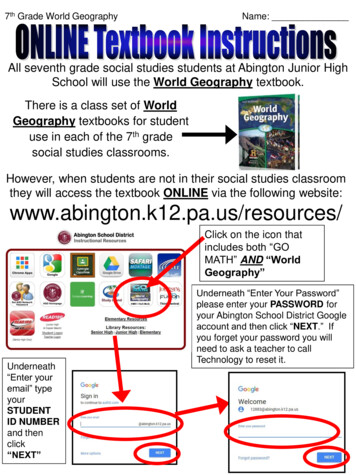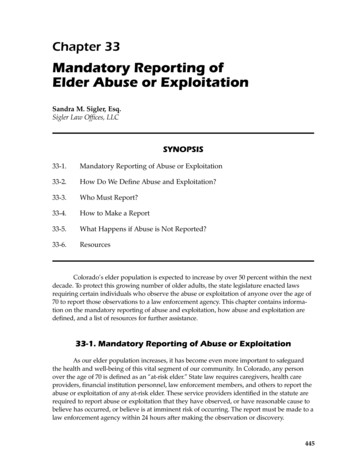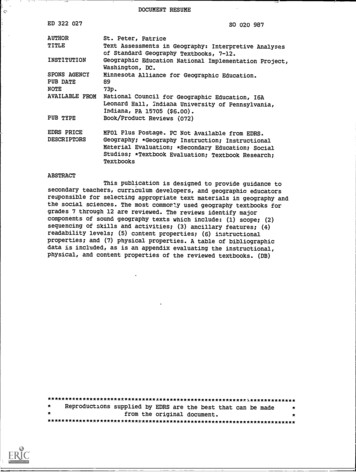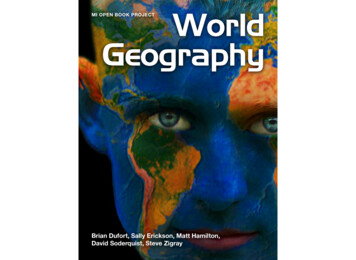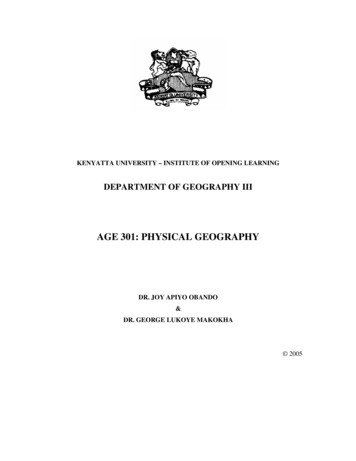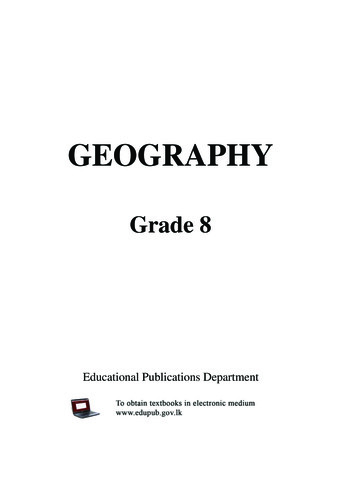
Transcription
GEOGRAPHYGrade 8Educational Publications Department
First Print-2016Second Print -2017Third Print-2018Fourth Print -2019All Rights ReservedISBN 978-955-25-0136-4Published by Educational Publications DepartmentPrinted by Saraswathi Publications,No. 2/60, Circular Road, Divulapitiya.ii
The National Anthem of Sri LankaSri Lanka MathaApa Sri Lanka Namo Namo Namo Namo MathaSundara siri barinee, surendi athi sobamana LankaDhanya dhanaya neka mal palaturu piri jaya bhoomiya ramyaApa hata sepa siri setha sadana jeewanaye mathaPiliganu mena apa bhakthi pooja Namo Namo MathaApa Sri Lanka Namo Namo Namo Namo MathaOba we apa vidyaObamaya apa sathyaOba we apa shakthiApa hada thula bhakthiOba apa alokeApage anupraneOba apa jeevana weApa mukthiya oba weNava jeevana demine, nithina apa pubudukaran mathaGnana veerya vadawamina regena yanu mana jaya bhoomi karaEka mavakage daru kela bevinaYamu yamu vee nopamaPrema vada sema bheda dureradaNamo, Namo MathaApa Sri Lanka Namo Namo Namo Namo Mathaiii
wms fjuq tl ujlf. orefjdatl ksjfiys fjfikdtl mdge;s tl reêrh fõwm lh ; ÿjkdtneúks wms fjuq fidhqre fidhqßfhdatl f,i tys jefvkdÔj;a jk wm fuu ksjfiafid k isáh hq; fõieug u fu;a lreKd . fKkSfj S iu.s oñkSrka ñKs uq; fkd j th u h iem;dlsis l, fkdu Èrkdwdkkao iurfldakaJ uõ UPÒ õ õ Áõ Jß Ó õ ÁõÊ CÀ» ß Ó Eh¼À Kk Jß Ó S v {Ó AuÚõÀ \ Põuµº õ õ Áõ JßÓõ ÁõÊ ÁÍ õ ßÓõ CÆ CÀ¼Û » » ÁõÌuÀ Ásk ß Óõ õÁ Aß P øn²hßJØÖø ]ÓUP ÁõÌ vkuÀö õßÝ o² zx À» & Ax Á õßÖ È õa ö\ÀÁ ß Óõ.BÚ u \ µU PõßPÂøu ß ö º .iv iv
v
ForewordThe educational objectives of the contemporary world are becomingmore complex along with the economic, social, cultural and technologicaldevelopment. The learning and teaching process too is changing in relation tohuman experiences, technological differences, research and new indices.Therefore,it is required to produce the textbook by including subject related informationaccording to the objectives in the syllabus in order to maintain the teaching processby organizing learning experiences that suit to the learner needs. The textbook isnot merely a learning tool for the learner. It is a blessing that contributes to obtaina higher education along with a development of conduct and attitudes, to developvalues and to obtain learning experiences.The government in its realization of the concept of free education hasoffered you all the textbooks from grades 1-11. I would like to remind you thatyou should make the maximum use of these textbooks and protect them well. Isincerely hope that this textbook would assist you to obtain the expertise to becomea virtuous citizen with a complete personality who would be a valuable asset to thecountry.I would like to bestow my sincere thanks on the members of theeditorial and writer boards as well as on the staff of the Educational PublicationsDepartment who have strived to offer this textbook to you.W. M. Jayantha Wickramanayaka,Commissioner General of Educational Publications,Educational Publications Department,Isurupaya,Battaramulla.2019.04.10vi
Monitoring and Supervision- W. M. Jayantha WickramanayakaCommissioner General of Educational PublicationsDirection- W. A. Nirmala PiyaseeliCommissioner (Development)Educational Publications DepartmentCo-ordination- Anupa Madhupani WeerarathneAssistant CommissionerEducational Publications Department- J. W. Rumesh Jayalath (2019)Assistant CommissionerEducational Publications DepartmentPanel of EditorsProf. N. K. Dhangalla(Emeritus Professor)- University of KelaniyaProf. S. A. Norbert- University of ColomboR. P. Peiris- Additional Commissioner (Retired)Department of ExaminationsA. R. S. Perera- Assistant Director of EducationBilingual Education BranchMinistry of EducationAnupa Madhupani Weerarathne- Assistant CommissionerEducational Publications DepartmentM. P. Ranjini Dhanawardhana- Director, Department of Social ScienceNational Institute of EducationS. Karunakaran- LecturerNational Institute of EducationPanel of WritersKarunasinghe Somadasa- ISA (English), Zonal Education OfficeMataraD. M. J. Bandara- Teacher, Kuli/Saranath M.V.Kuliyapitiyavii
W. A. A. R. Weragoda- TeacherGirls' High SchoolKandyW. K. P. Dhanawardhana- Teacher, St. Peter's CollegeNegomboN. A. Chithralatha- ISA, Zonal Education OfficeMataraK. K. U. Gunarathne- TeacherG/ Polpagoda M.V, YakkalamullaYalini Karunagaran- TeacherSt. Clare's CollegeColombo 06T. Sharamiladharshini- TeacherK/W/Rajawella Hindu National CollegeDiganaT. Srisureshkumar- ADE, Zonal Education OfficeMataleS. Ilankovan- Bt/KK/Karuwakerny Vigneswara CollegeKaruwakernyValachchanaiLanguage EditorM. P. A. M. Weerarathne- Assistant CommissionerEducational Publications DepartmentProof ReaderH. Dahanayake- Chief Editor - (Retired)Educational Publications DepartmentCover DesignR. A. Yureka Dilrukshi- IT UnitEducational Publications DepartmentType Setting (Formatting)Maps, Figures and Page SettingAbisheka RanasinghegeR. A. Yureka Dilrukshiviii- IT UnitEducational Publications Department- IT UnitEducational Publications Department
Content11The SolarSystem2Uniqueness ofthe Earth as ahabitat of theliving beings173South Asia294The basicfeatures of1: 50 000topographicmaps ofSri Lanka49ix
x
1The Solar SystemThe objective of this unit is to studythe composition and functions of thesolar system.1Fo r Fre e D i st ri b u t i o n
Have you carefully observed the sun, the moon and the other celestial bodies in thesky? There is evidence that man had shown an interest in knowing about them sinceancient times. At present, man can explore more than what is visible to the nakedeye, as scientists have invented modern equipment to observe the sky.It has been discovered that there are eight planets, shapeless pieces of planetscalled asteroids, various celestial bodies such as dwarf planets and naturalsatellites revolving around the sun. When all these things are taken together,we consider it as a system. This is called the solar system. It is believed thatthe solar system has been formed 4600 million years ago, by combining dustparticles and gases together.When we observe the night sky with our naked eyewe can see a multitude of stars. Stars are celestialbodies that emit light and heat. Thus, they aresources of energy. They can be seen shining ortwinkling in the night sky.The sun is a star thatemits light and heat.However, the other celestial bodies such as planets, natural satellites andasteroids, though they do not emit light, are visible in the night sky as theyreflect the sunlight. They are seen with a "monotonous light that does nottwinkle".Observe the cloudless, clearly visible night sky and get the above informationconfirmed.2Fo r Fre e D i st ri b u t i o n
Composition of the solar systemThe Sun and the other celestial bodies which are bound by the gravitational forceof the Sun belongs to the solar system.The celestial bodies found in the solar system are listed below.² The Sun, the main body of the solar system² Planets, the largest celestial bodies² Smaller planets or dwarf planets² Natural satellites of the planets² Millions of other rock particles or debris» Asteroids» Comets» MeteoroidsuSatrnJu pUranusM a lutoMakemakeCeresCometFig. 1.1 - Solar systemSource - /solarsystem-21.jpg 21/02/20163Fo r Fre e D i st ri b u t i o n
The SunThe Sun is the main source that provides energy for the existence of life onEarth. The Sun lies at the centre of the solar system. A massive amount of heat isgenerated at the core of the Sun as a result of fusion and thermonuclear reactions.The temperature of the centre of the Sun is about 15,000,0000C (15 million 0C)while the surface temperature is about 60000C.Several important facts about the sun are given below;² It holds 99.86 percent of the total mass of the solar system or the substancesthat belong to the whole system.² Its extent is 109 times of the diameter of the Earth. The diameter is 1.4 millionkilometres.² It is a source of energy and it provides energy and heat to all the planets in thesolar system.² Solar storms occur on the surface of the Sun and on such occasions flameswould burst out from the Sun.² The Sun revolves around its own axis. The time taken for one rotation is 25.4Earth days.Fig. 1.2 - The SunSource - http://nssdc.gsfc.nasa.21/02/2016Fig. 1.3 - the Coronal loops that gives outheat on the Sun's surfaceActivity 1.11. Name the types of celestial bodies that belong to the solar system.2. Explain how planets and stars differ from each other.3. Write four specific features of the Sun.4. Prepare an article for a wall paper about the Sun, using information frombooks, newspapers, magazines and the internet.4Fo r Fre e D i st ri b u t i o n
PlanetsSpherical objects thatare moving on orbitsaround the Sun arecalled planets.The solar system consists of 8 mainplanets. They are Mercury, Venus, Earth,Mars, Jupiter, Saturn, Uranus and Neptune.Between Mars and Jupiter there is a belt ofasteroids. Planets have been divided intotwo categories as inner planets and outerplanets.² Inner planetsThe planets located between the Sun and the belt of asteroids are known as innerplanets (Study Fig. 1.1). They are composed of rocks made up of silicate and metalmaterials. Mercury, Venus, Earth and Mars belong to the category of inner planets.² Outer planetsThe planets located out of the belt of asteroids are known as outer planets.Jupiter, Saturn, Uranus and Neptune belong to this category. They are basicallygaseous in composition (Hydrogen and Helium).Mercury² Mercury is the closest planet to the Sun.² It is the smallest planet of the solarsystem. It is a bit larger than the Moon,the natural satellite of the Earth, in size.² The temperature is extremely high dueto its close proximity to the Sun andslow rotation. The surface temperatureis about 1670C.² There are craters on the surface due tovolcanic eruptions.Fig. 1.4 - MercurySource - www.windows2universe.org/ 13.02.2016² It has no atmosphere. Therefore, these is ahigh risk of falling asteroids and meteors.² Mercury has no satellites.5Fo r Fre e D i st ri b u t i o n
Venus² Venus is the second planet according tothe distance from the Sun.² It is the closest planet to the Earth.² It is the planet with the highest surfacetemperature (4640C).² The main gas found in this planet isCarbon dioxide (96%).² It is somewhat smaller than the Earth insize.Fig. 1.5 VenusSource - www.windows2unverse. 13.02.2016² It is the planet most clearly visible in the night sky.² The surface of the planet is covered by a thick layer of clouds. Therefore, itssurface cannot be seen well. It is visible brightly in the sky due to the reflectionof the Sun’s rays by this thick layer of clouds.² Rotation from East to West is a special feature of this planet.² During one period of the year it is clearly visible in the eastern sky beforedawn and during another period, in the western sky after sunset. Hence, Venusis called the Morning Star as well as the Evening Star.² Venus has no satellites.Earth²Earth is the planet which we live on.²It is the third planet from the sun indistance and it is the largest among theinner planets.²It is visible as an attractive celestialobject in blue when it is seen fromouter space. Hence, it is called the BluePlanet.²According to the information found uptodate, it is the only planet with life.6Fo r Fre e D i st ri b u t i o nFig. 1.6 - The Earth(A photography taken from Appollo 17)Source - www.windows2universe.13/02/2016
² Existence of water, congenial atmospheric composition and the gravitationalpower are the reasons for the existence of life on Earth.² The Earth has one natural satellite called the Moon.Mars² Mars is the fourth planet from the Sunaccording to distance.² It is called the Red Planet since it isvisible as a reddish object in the nightsky.² We can see Mars with the naked eyeas it is the second closest planet to theEarth.² There is a thin atmosphere and carbondioxide is the predominant gas.² Mars has two satellites called Phobosand Deimos.Fig. 1.7 - MarsSource - www.windows2universe.org/13.02.2016JupiterFig. -1.8 - JupiterFig. 1.9 - A close photo shot of the surface of JupiterSorce - http://nssdc.gsfc.13/02/2016Source - www.windows2universe.org/our so13/02/2016² Outer planets begin with Jupiter.² Among the planets, Jupiter is the fifth planet from the Sun and it is the largestplanet in the solar system.7Fo r Fre e D i st ri b u t i o n
² The diameter of the Jupiter is 1,42,984km and it is ten times more than thediameter of the Earth.² The regions like black stripes as well as bright regions can be seen on thesurface of Jupiter (See fig.1.8).² Jupiter has the highest gravitational force among the planets in the solarsystem.² Jupiter has the largest number of natural satellites. According to theobservations upto date, it has 67 natural satellites.Saturn² Saturn is the sixth planet from theSun.² It is the second largest planet and it isabout nine times the size of the Earth.² Saturn has an attractive set of "rings "around it. These rings are formed ofice particles of different sizes.² Saturn has 62 natural satellites.Fig. 1.10 - SaturnSource - Image courtesy of NASA, ESA, J. Clarke(Boston University) and Z. Levay (STScIUranus² Uranus is the seventh planet from theSun.² It is the third largest planet in the solarsystem.² It has been found that Uranus too hasa thin set of rings around it.Fig. 1.11 - Uranus² It has 27 satellites.Source - http://s3.amazonaws.com/kidzworld photo8Fo r Fre e D i st ri b u t i o n
Neptune² Neptune is the eighth planet and the onefarthest from the Sun.² It is seen in blue.² It is four times larger than the Earth.² Neptune is extremely cold due to thelong distance from the Sun.² It has 14 natural satellites.Fig. 1.12 - NeptuneFacts about planets in briefTable 1.1 - Facts about ptune49528RotationperiodP eriod 00No. ofsatellitesSource - http://nssdc.gsfc.nasa.gov/planetary/factsheet 21/02/2016Rotates from east to west.Activity 1.21. Name the planets in the ascending order according to the distance from theSun.2. Categorize them as inner and outer planets.3. Present the composition of the solar system in a diagram.9Fo r Fre e D i st ri b u t i o n
Assignment1. Prepare a brochure including information about planets.2. With the teacher's instructions prepare a model of the solar system usingmaterials that could be found easily.Dwarf planetsThe small planets which have no fixed orbits are known as dwarf planets. At presentfive planets have been identified as dwarf planets (International AstronomicalAssociation 2006). However, scientists believe that there may be more than five.The five dwarf planets are shown in the picture below.ErisMakemakeCeresHaumeaPlutoFig. 1.13 - Dwarf PlanetsSource - 6/02/ensystemNatural satellitesThe celestial objects that orbit around the main planets are called natural satellites.So far, scientists have identified 173 such satellites that belong to the main planetsand eight satellites that belong to the dwarf planets.10Fo r Fre e D i st ri b u t i o n
Table 1.2 - Number of natural satellites in the solar systemMercury VenusPlanetsNo. ofsatellitesDwarfplanetsEarthMarsJupiter Saturn Uranus Neptune001267CeresPlutoHaumeaMakemakeEris05201No. ofsatellites622714Source - http://nssdc.gsfc.nasa.gov/planetary/factsheet 21/02/2016AsteroidsAsteroids are usually considered asfragments of rock left over when formingthe solar system. They are formed withhard rocks and they are of different shapesand sizes. More than millions of asteroidscan be found between the orbits of Marsand Jupiter (Observe fig. 1.1).Fig. 1.14 - An asteroidActivity 1.31. State the number of natural satellites with the planets in the solar systemaccording to the information found so far.2. Describe what dwarf planets are and name the dwarf planets found so far.Beliefs connected with the solar systemDifferent beliefs exist in the society regarding the impacts ofthe Sun, the Moon and the other planets on the lives of people.11Fo r Fre e D i st ri b u t i o n
Several such beliefs are mentioned below.² Worshiping the Sun and the Moon considering them as gods.² Emergence of the astrology on the basis of the movements of the Sun and theMoon and the other planets.² Holding ritualistic activities known as 'Shanthe karma', due to the belief thatplanets have malefic or bad effects.² The preparation of the horoscope on the basis of the locations of planets at thetime of the birth and prevalence of the belief in society that many things aredetermined by the influence of planets.² There are various ceremonies on the basis of the Sun and the Moon. (Thaipongalfestival, Sinhala and Hindu New Year festival and Ramalan Festival)Fig. 1.15 - Sinhala and Tamil new year festivalFig. 1.16 - Thaipongal festival² Organization of traditional farming activities based on the influence of theSun and the Moon. Accordingly, they have the belief that they would reap agood harvest, receive rain on time and have less harm from pests.² Considering the direction when collecting the parts of herbal plants used forAyurvedic treatment and the belief that it has the influence of the Moon.Though it is difficult to come to a definite conclusion about these beliefs, they havea practical importance.12Fo r Fre e D i st ri b u t i o n
New knowledge about the solar system² The early man used to explore the unseen universe even at the time when sciencewas not developed. New information about the solar system and the universe iscontinuously added due to the explorations and observations done for a long periodsince past.² Galileo Galilee used the telescope to observe the universe for the first time in1610 A.C. He was able to reveal more information about the universe not knownso far, through the observation conducted using his telescope.Fig. 1.17 - Galileo GalileeFig. 1.18 - Telescope used byGalileo GalileePerson like Claudius Ptolemy, Nicolas Copernicus, Johannes Kepler and IsaacNewton too were enthusiastic in finding information about the universe in thepast.The launching of an artificial satellite to explore information about space in1957 A.D by USSR (Russia) is an important event in the history. ThereafterUnited States of America established the National Aeronautics and SpaceAdministration (NASA) and launched several satellites. Images taken by thesesatellites have helped in broadening the knowledge about the universe.It was believed that the solar system has nine planets, Mercury, Venus, Mars, Jupiter,Saturn, Uranus, Neptune and Pluto including our living planet Earth. But, in 200613Fo r Fre e D i st ri b u t i o n
the International Astronomical Institute declared Pluto as a dwarf planet. Hence,hereafter it is considered that the solar system has eight planets. It was acceptedthat there are celestial objects called dwarf planets among other planets that belongto the solar system.Recently, the "Caltech" Astronomical Institute in U.S.A. revealed informationabout a ninth planet which is ten times larger than the Earth. This planet has beennamed as Planet 9. But, it has not been proved yet as a member of the solar system.As a result of continuous exploratory activities, the knowledge about the space ischanging day by day.Fig. 1.19 - Neil Armstrong'sfirst step on the MoonFig. 1.20 - Launching of a rocketActivity 1.41. Prepare a list of the modern discoveries about the solar system.2. (a) Mention four beliefs found in the Sri Lankan society on the basis of theSun and the Moon.3. (b) State some other beliefs that you are aware of and have heard from yourelders which are not included in the textbook.14Fo r Fre e D i st ri b u t i o n
Sources² pg² www.windows2universe.org/our solar system/solar system.html 13.02.2016² http://s3.amazonaws.com/kidzworld 1c25e/uranus.jpg² 6/02/en10-exploringthe-solar-system 06.jpg² Image courtesy of NASA, ESA, J. Clarke (Boston University), and Z. Levay(STScI² http://nssdc.gsfc.nasa.gov/planetary/factsheet 21/02/2016² http://nssdc.gsfc.nasa.gov/planetary/factsheet 21/02/2016² f/Moons of solar system v7.jpgGlossary²Solar systemfi!r.%y uKav,hbõ ØÖz �øP²Planet.%yf,dalh PõÒ²Asteroids.%ylG›PØPÒ²Natural SatellitesWm .%yhkaE PõÒPÒ²Dwarf planetsjduk .%yhka]Ö PõÒPÒ²Gravitational force. re;ajdl¾IK n,hDº Âø\15Fo r Fre e D i st ri b u t i o n
²Thermonuclear reactions;dm kHIaál m%;sl%shd öÁ Aq«Ò uõUP ²MassialkaOhvoIJSolar stormsiQ¾h l Kdgqbõ ØÖ À²AxiswlaIhAa²Inner PlanetswNHka;r .%yf,dalAPU PõÒPÒ²Outer planetsndysr .%yf,dal ÓU PõÒPÒ²Ice particleswhsia wxY ÛzxoUøPPÒ²Artificial satelliteslD;%su pkaøsldö\ ØøPU PõÒ²Satellite imagespkaøsld m%;sìïnö\ v i [PÒ²AstrologyfcHda;s¾ úoHdjÁõÚ\õìvµ16Fo r Fre e D i st ri b u t i o n
2Uniqueness of the Earth as ahabitat of living beingsThe objective of this unit is to findfacts about the uniqueness of theplanet Earth in the solar system.17Fo r Fre e D i st ri b u t i o n
Basic information about the EarthDistancefrom the sunDuration ofrotation150 millionkm23 hours and56 minutesSpeed of therotation(in the Equator)0.46 km persecondTime forrevolutionSpeed of therevolution365 daysand 6 hours29.8 km fora secondSource - http://nssdc.gsfc.nasa.gov/planetary/factsheet 21/02/2016The Earth is a spherical object with an area of 510 million square km. Though theEarth is considered as a globe, the equatorial diameter is longer by 42 km, than thepolar diameter. Therefore, it is not considered as a mathematical sphere.²Equatorial diameter12756 km²Polar diameter12714 kmLocation of the Earth in the solar systemIn unit 1, you have studied that the Earth, our home planet, is the third planet from the Sun.Study the following facts too.²The average surface temperature on Mercury, located very close to theSun, is 1670 C.²The average surface temperature on Venus, the second planet from the Sun,is 4640C.²The average surface temperature on the Earth is 150C.18Fo r F ree D i st ri b u t i o n
²The average surface temperature on Neptune, the farthest planet from theSun is -2000C.Source - http://nssdc.gsfc.nasa.gov/planetary/factsheet 21/02/2016Temperature on the Earth is not as high as on the Mercury and Venus or not as low ason the Neptune as it is located in a middle position in the solar system.The following factors contribute the Earth to become a habitat for living beings;² Presence of an atmosphere with favourable gases as well as watervapour congenial to living beings.² Existence of water.² Prevalence of a intermediate temperature.² Occurrence of rotation and revolution.² Existence of gravitational force.According to the experiments conducted so far, the Earth is the only planet withlife. The Earth contains distinct features that cannot be compared to another planetin the solar system; hence, it occupies a unique place in the solar system.Latitudes and LongitudesA network of imaginary lines has been drawn on the model globe to identify anyplace located on the Earth. These lines are named as latitudes and longitudes.LatitudesThe imaginary line that separates the Northern andSouthern Hemispheres of the geographical globeis the zero (00) latitude known as the Equator. Thelatitudes that run parallel to the equator in the NorthernHemisphere up to 900 are identified as Northernlatitudes and the latitudes that run parallel to the equatorup to 900 in Southern Hemisphere are identified asSouthern latitudes respectively. The circles of latitudesgradually become smaller when they are extended upto Northern and Southern poles. Ultimately it becomesa point in the South and North poles (Fig. 2.1).Fo r Fre e D i st ri b u t i o nNorthPoleFig. 2.1 - Latitudes19
LongitudesThe imaginary lines on the geographical globe thatextend from the North pole to the South pole are calledlongitudes. The 00 longitude that runs across the city ofGreenwich in England, is called the Greenwich Meridian.The longitudes that are located up to 1800 east fromthe Greenwich meridian are called Eastern longitudesand those that extend up to 1800 West are called westlongitudes. But the longitude 1800 is considered as oneand it is not classified as a western or eastern longitude.Rotation of the EarthNorthPoleEquatorSouth PoleFig. 2.2 - LongitudeWestThe movement of the Earth around its own axis is calledthe rotation. The Earth rotates from the West to the Easton this imaginary axis that runs from the North pole tothe South pole. The Earth's axis tilts at an angle of 23.5 to the orbital plane.Due to the rotation of the Earth, we see as if the Sun risesin the east and sets in the west. The Earth takes 23 hoursand 56 minutes for a complete rotation around its axis.But the duration of a day of the Earth is considered as24 hours.North PoleEastRotating AxisSouth PoleFig. 2.3 - The Earth axisand rotationOccurrence of day and nightThe rotation of the Earth results inthe occurrence of day and night andregional differences in time.Fig. 2.4 - Occurrence of day and nightWhile, rotating, the half of the Earth thatreceives sun light has day time. The otherside that does not get sunlight has nighttime.20Fo r F ree D i st ri b u t i o n
According to the location of the longitudes, theMorning 6.00Texas (U.S.A)time too differs in different places in the world.Observe Fig. 2.5 to understand how timechanges in the world. When the time is 12.00 MiddayMidnightNew Zealandnoon on a longitude, the Sun is overhead. The Englandtime is 12.00 midnight on its opposite longitude.The Sun rises early in the countries located inthe eastern part of the world as a result of theEvening 6.00Bangladeshrotation of the Earth from the West to the EastFig. 2.5 – how different places of the worldand the Sun rises ralatively later in the Westernare affected by the location of longitudes.countries.Source - http://www.nauticed.org/When the Earth rotates around its axis once, itmoves 3600 during 24 hours. Within one hour itmoves 15 of longitudes and requires 4 minutes to travel within two longitudes. Hencethe time between two longitudes defers by 4 minutes. Hence, there are time differencesin different places on earth according to the change of latitude.Standard timeThe Earth has been divided into 24 regions or time zones on the basis of longitudes forthe use of internationally accepted standard time. Usually, a standard time is used in eachof the zones. But, there are large countries that extend over several time zones in theworld. The United States of America, Canada, Australia and Russia are some of them.The time zones relevant to the particular region is used in these countries (See map 2.1).LongitudesMap 2.1 - Standard time zonesFo r Fre e D i st ri b u t i o nVariation of time(hours)21
It is considered that the day breaks at 12.00 midnight. The Greenwich meridian isconsidered as the 00 longitude. From the Greenwich Meridian 15 longitudes towardseast one hour is added to the time and one hour is reduced towards 15 longitudes tothe west from the Greenwich meridian. The International Date Line is set based on1800 longitude and there is one day difference either side of this line.For example, suppose that the time at Greenwich city is 12.00 noon on a Monday.From there, the time increases regularly towards the east till night. On this occasion,the time in Sri Lanka is 5.30 pm. In the same manner, the time decreases regularlyup to morning from Greenwich city towards the west. On this occasion the time inTexas State in the United States of America is 6.00 am. According to this change,the time on International Date Line is 12.00 midnight.Here, there is another factor to be understood. According to the above example,when moving towards 1800 east from 00 longitude, the time is 12.00 midnight onMonday. When moving towards 1800 west the time is 12.00 daybreak. So, themorning has just dawned or 12.00 midnight on Monday. Therefore, when crossingthe 1800 longitude, the clocks should be adjusted accordingly as there is a differenceof one day on either side of it.If the1800 longitude is marked as a straight line, it divides some countries. Then,these countries may face an inconvienience in using the same date for the wholecountry. As a solution, 1800 longitude, which is also the International Date Line(IDL) is marked avoiding crossing these countries.Activity 2.11. State the specific features of the Earth that caused the formation and sustainabilityof life.2. “The location of the Earth related to the Sun is the main factor that caused theexistence of life”. Explain this.3. State what is known as the rotation of the Earth and write its two main results.4. State the time zone Sri Lanka belongs to and mention the difference of the timein relation to the Greenwich Mean Time (GMT).5. Name three countries that observe the Local Standard Time22Fo r F ree D i st ri b u t i o n
Revolution of the EarthThe movement of the Earth around the Sun is called revolution, and its path iscalled the orbit. The Earth takes 365 days and 6 hours for a complete revolution.A duration of 365 days is considered as one year. We add the balance 6 hours of 4years together and every four years. We have an year with 366 days which is calleda Leap year.Since the Earth rotates on an axis with a 23.50 inclination, the Sun comes directlyabove different longitudes during particular periods of the year. Therefore, thelength of the day and night changes according to the location of latitudes andseasonal changes occur in
² The temperature is extremely high due to its close proximity to the Sun and slow rotation. The surface temperature is about 1670C. ² There are craters on the surface due to volcanic eruptions. ² It has no atmosphere. Therefore, these is a high risk of falling asteroids and
